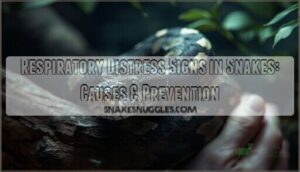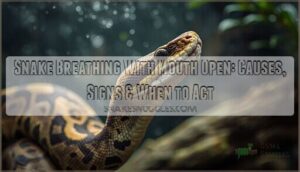This site is supported by our readers. We may earn a commission, at no cost to you, if you purchase through links.
A single undetected mite infestation in your collection can cascade into respiratory disease, septicemia, and death across multiple animals within weeks, yet most captive snake mortalities stem from entirely preventable conditions rather than untreatable pathologies.
Fungal infections, bacterial sepsis, parasitic loads, and viral diseases don’t emerge spontaneously—they proliferate in environments where husbandry protocols break down, biosecurity measures fail, or owners miss early clinical signs.
Your snake’s immune system functions optimally within narrow environmental parameters, and deviations in temperature, humidity, or hygiene directly compromise its ability to resist pathogens that exist in every enclosure.
Understanding how to prevent snake diseases requires recognizing that prevention isn’t a single intervention but a systematic approach integrating enclosure sanitation, environmental control, quarantine protocols, and veterinary oversight to eliminate the conditions that allow disease transmission and pathogen proliferation.
Table Of Contents
- Key Takeaways
- Why Preventing Snake Diseases is Essential
- Maintain Optimal Snake Enclosure Hygiene
- Control Environmental Factors to Reduce Disease
- Practice Biosecurity and Parasite Prevention
- Schedule Regular Health Checks and Veterinary Visits
- Frequently Asked Questions (FAQs)
- How to prevent disease transmission from animals?
- What is the best thing to prevent snakes?
- How can you prevent snake fungal disease?
- How do I keep my snake healthy?
- How to prevent illness in snakes?
- How can snake fungal disease be prevented?
- How do we protect snakes?
- How do you keep snakes healthy?
- What are the risks of owning multiple pet snakes together?
- How often should I clean my snakes water bowl daily?
- Conclusion
Key Takeaways
- Most snake deaths result from preventable husbandry failures rather than untreatable diseases, with environmental deviations in temperature, humidity, or hygiene directly compromising immune function and enabling pathogen proliferation in enclosures.
- Effective disease prevention requires systematic integration of enclosure sanitation protocols, quarantine periods of 60-90 days for new arrivals, dedicated equipment per animal to prevent cross-contamination, and regular fecal testing every 6-12 months to detect parasites before clinical symptoms emerge.
- Environmental control demands precise thermal gradients (warm side 88-95°F, cool side 75-80°F), humidity maintenance between 40-60%, and at least two hiding spaces to reduce stress-induced immunosuppression that increases disease susceptibility.
- Zoonotic transmission risks, particularly Salmonella infection through the fecal-oral route, require rigorous handwashing protocols after every handling session and equipment contact to protect both human and animal health.
Why Preventing Snake Diseases is Essential
You can’t afford to wait until symptoms appear, because by then, your snake may already be fighting a losing battle against infection, organ damage, or systemic disease.
That’s why understanding the early warning signs of snake bacterial infections can mean the difference between a quick recovery and a devastating outcome.
If you wait for symptoms, your snake may already be losing the battle against infection or organ damage
Prevention isn’t just about avoiding vet bills—it’s about protecting your snake from painful conditions like fungal lesions, respiratory infections, and parasitic infestations that can shorten their lifespan by years.
Regular health checks also help you spot behavioral changes—like when your Okeetee corn snake stops eating or becomes unusually lethargic—that signal underlying issues before they become serious.
Understanding the specific risks, how they affect your snake’s body, and what dangers they pose to you and your family will help you build a care routine that keeps everyone safe.
When housing multiple snakes, feeding them separately prevents competition stress and accidental injuries during meals.
Risks of Common Snake Diseases
Understanding disease risks forms the foundation of protecting your snake’s well-being. Fungal infections, particularly snake fungal disease caused by Ophidiomyces ophiodiicola, create severe skin lesions and tissue necrosis that compromise mobility and feeding.
Bacterial risks like septicemia and stomatitis lead to systemic infection, dehydration, and potentially fatal outcomes, while inadequate parasite control allows internal nematodes and external mites to cause anemia, weight loss, and increased snake mortality through disease transmission.
Regular veterinary check-ups can help identify and manage reptile health issues to prevent the spread of disease.
Impact on Snake Health and Longevity
Disease transmission accelerates health decline in your snake through multiple pathways. When infections take hold, you’re facing serious threats to longevity factors:
- Viral diseases like inclusion body disease cause irreversible organ damage and neuromuscular paralysis, with death occurring within weeks to months
- Bacterial septicemia overwhelms the immune response, leading to systemic failure and snake mortality if veterinary medicine for snakes isn’t promptly applied
- Parasitic loads create chronic anemia and inflammatory bowel disease, compromising snake health and wellness through nutritional depletion
Early reptile disease treatment determines survival outcomes. Understanding reptile parasite issues is essential for effective care.
Zoonotic Disease Concerns for Owners
Beyond your snake’s welfare, you’re exposed to zoonotic diseases through direct snake handling and contaminated environments. Salmonella infection poses the greatest human risk factors, causing severe gastroenteritis in children under 5 and immunocompromised individuals.
Disease transmission occurs via the fecal-oral route when hand washing protocols fail after pet care activities, underscoring why public health and awareness initiatives emphasize proper hygiene in reptile ownership for pet health and safety.
Maintain Optimal Snake Enclosure Hygiene
You can’t prevent snake diseases without controlling the environment where they live, and that starts with the enclosure itself.
Proper hides are essential—choosing the right snake hide means prioritizing size, placement, and security to keep stress levels low.
A clean habitat isn’t just about aesthetics—it directly reduces pathogen load, limits exposure to fungal spores and bacteria, and minimizes the risk of parasitic infestations that thrive in unsanitary conditions.
Here’s how to maintain enclosure hygiene that actually protects your snake’s health.
Cleaning and Disinfecting Cages
You can’t prevent diseases in captive snakes without thorough cage sanitization protocols that target bacterial, viral, and fungal pathogens through consistent hygiene protocols and evidence-based disinfectant options. Effective enclosure maintenance requires understanding cleaning schedules, proper biosecurity and hygiene techniques, and veterinary care standards to support disease prevention and management alongside parasite control and management for superior reptile care outcomes.
Essential cleaning schedules include:
- Daily spot cleaning removes waste, uneaten food, and shed skin to prevent pathogen accumulation and support your snake’s health
- Weekly to bi-weekly partial cleaning involves changing bedding, disinfecting water dishes, and sanitizing decor to maintain biosecurity standards
- Deep cleaning every 2-3 months requires complete substrate replacement and thorough enclosure disinfection using approved agents
For cage sanitization, you’ll need appropriate disinfectant options that effectively eliminate pathogens without harming your snake. Diluted bleach at 10% concentration (1 part bleach to 9 parts water) requires 10-20 minutes of contact time, though thorough rinsing afterward is critical since residual bleach can cause dermal absorption injuries or oral toxicity. F10SC veterinary disinfectant, diluted at 1:250 (approximately 4 mL per liter), provides broad-spectrum efficacy against bacteria, viruses, fungi, and spores with similar contact times while being safer for reptile care when used at recommended concentrations. Chlorhexidine solutions at 0.5% to 2% offer effective disinfection with shorter contact times of 30 seconds to 2 minutes, leaving no toxic residues and producing no harmful fumes.
Your enclosure maintenance protocol should prioritize proper application techniques to boost pathogen elimination while minimizing chemical exposure risks. Work in well-ventilated areas, wear protective gloves, and rinse all surfaces thoroughly after disinfection to remove chemical residues that could compromise your snake’s integumentary or respiratory health. Avoid toxic products including pine or cedar oils, phenolic compounds, or scented cleaners, as these can cause severe toxicity in reptiles through dermal contact or inhalation. Steam cleaning offers a chemical-free alternative that effectively kills bacteria through high-temperature exposure without introducing potentially harmful residues into the environment.
Water bowls and accessories demand daily cleaning with hot water and unscented dish soap, followed by disinfection using 12% hydrogen peroxide for approximately 10 minutes or soaking in bleach solution (half cup per gallon of water), then rinsing thoroughly to prevent chemical ingestion. Hides and branches require cleaning with hot, soapy water, while wooden items can be sterilized by soaking in bleach solution (1/3 to 1/2 cups per gallon) for 24 hours or baking at 250°F for 30-60 minutes to ensure complete pathogen destruction.
Complete substrate removal during deep cleaning allows you to spray the enclosure with disinfectant, scrub all surfaces, and allow proper drying before introducing fresh substrate, creating an environment that won’t support pathogenic organism proliferation. Consider leaving enclosures vacant for at least 2 weeks after disinfection when dealing with known infectious diseases, as this quarantine period ensures complete pathogen eradication before reintroducing your snake. Monitor enclosure conditions continuously between scheduled cleanings to identify when additional intervention may be necessary based on waste production, humidity levels, or visible contamination that could compromise your disease prevention and management efforts.
Safe Handling of Equipment and Tools
Tools used for snake handling and enclosure maintenance require rigorous equipment disinfection protocols that support biosecurity and hygiene standards in reptile handling and management.
You should implement tool segregation by dedicating separate hooks, tongs, and feeding implements to each snake, then disinfecting these items with F10 veterinary disinfectant, chlorhexidine, or diluted bleach for 5–15 minutes between uses, following proper storage methods and cleaning protocols while wearing personal protection equipment.
Preventing Cross-Contamination Between Snakes
Cross-contamination pathways operate silently through substrate particles, fecal residue, and fungal spores, transferring between snakes via shared surfaces, handler contact, and improperly sanitized equipment. This creates disease transmission networks within collections, demanding systematic isolation protocols and strict sequential handling procedures to interrupt.
To mitigate these risks, handle healthy snakes before potentially infected individuals and maintain isolation between enclosures using dedicated tools for each animal. Implement quarantine protocols that segregate new arrivals for 60–90 days, monitoring for infectious stomatitis, parasitic infections, and ophidiomyces ophiodiicola.
Adhere to biosecure practices that prevent disease transmission across your collection through rigorous snake sanitation and hygiene standards, consistent with veterinary medicine recommendations for proper snake care.
Control Environmental Factors to Reduce Disease
Your snake’s environment plays a critical role in maintaining immune function and preventing opportunistic infections. Environmental stressors can weaken physiological defenses and increase disease susceptibility.
Temperature gradients, humidity levels, spatial enrichment, and population density all influence stress hormones like corticosterone, which directly impacts your snake’s ability to resist pathogens.
You can markedly reduce disease risk by controlling three key environmental parameters in your snake’s enclosure.
Managing Temperature and Humidity
You can’t overlook environmental regulation when disease prevention is at stake, as improper temperature control and humidity levels directly compromise immune function and create opportunities for bacterial, fungal, and parasitic infections. Here’s what you need to maintain for ideal snake care:
- Establish thermal gradients with a warm side at 88-95–°F and a cool side at 75-80–°F using appropriate heat sources like ceramic emitters or heat mats.
- Use programmable thermostats to prevent dangerous temperature fluctuations that impair digestion and immune responses.
- Maintain humidity levels between 40-60% to support shedding and prevent dysecdysis, which can lead to retained skin and secondary infections.
- Monitor both temperature gradient and humidity with digital thermometers and hygrometers placed at snake level for accurate readings.
- Ensure adequate ventilation systems to prevent excessive moisture buildup that promotes scale rot and respiratory disease while implementing biosecure practices.
Consistent environmental regulation, combined with humidity control, reduces physiological stress and maintains the metabolic processes essential for disease resistance.
Providing Adequate Hiding Spaces
Your snake’s immune function depends on psychological security as much as physical health, which means inadequate hiding spaces increase cortisol levels and suppress disease resistance. You need at least two hides—one in the warm zone and one in the cool zone—to support proper thermoregulation techniques and snake stress reduction.
Strategic hide placement strategies using smooth, non-porous materials like PVC provide environmental enrichment while preventing injury, and this hiding space design directly impacts reptile health by allowing natural behaviors that strengthen immune responses and reduce captivity-related immunosuppression.
Reducing Stress and Overcrowding
Overcrowding compromises your snake’s immune function through chronic stress, with mortality rates reaching 41% within ten days in high-density conditions, making proper enclosure design and stress management critical components of veterinary care for snakes.
You’ll prevent overcrowding risks and support stress reduction and prevention through:
- Housing snakes individually to eliminate competition, aggression, and disease transmission inherent in animal husbandry
- Providing minimum 4x2x2-foot enclosures for adult corn snakes and king snakes, allowing natural snake behavior
- Monitoring stress indicators like glass surfing, excessive hiding, or feeding refusal during routine snake care and husbandry
Practice Biosecurity and Parasite Prevention
Biosecurity protocols form the foundation of disease prevention in captive reptile collections, establishing barriers that protect both individual animals and entire populations from infectious agents and parasitic infestations.
Your responsibility as a snake keeper extends beyond maintaining clean enclosures to implementing systematic measures that intercept pathogens before they can establish themselves in your collection.
The following practices address the three critical control points where disease transmission most commonly occurs in reptile husbandry settings.
Quarantine New or Sick Snakes
Before introducing a new snake into your collection or when illness appears, quarantine is your most critical defense against disease transmission. You should isolate any new arrival or sick snake in a separate enclosure for at least 60-90 days, conducting thorough veterinary examinations, fecal tests for internal parasites, and diagnostic screening for pathogens like Snake Fungal Disease and Reptarenavirus to verify health status before integration.
Routine Parasite Screening and Control
Once your new snake has completed quarantine, establishing a routine parasite control program with regular health monitoring protects long-term wellness. You should schedule fecal analysis every 6-12 months to detect intestinal parasites through microscopy techniques like flotation and direct smears, which identify roundworms, protozoans, and other pathogens before clinical signs appear, enabling prompt deworming methods when parasite testing reveals infection.
- Conduct biannual parasite testing using fecal flotation to detect gastrointestinal helminth eggs
- Inspect your snake weekly for snake mites around eyes, heat pits, and ventral scales
- Implement parasite management protocols including environmental sanitation and follow-up screening post-treatment
Proper Hand Washing and Personal Hygiene
Handwashing techniques form your primary defense against zoonotic transmission, requiring 20-second scrubbing with soap and warm water after every handling session, enclosure cleaning, or equipment contact to remove Salmonella and fungal pathogens effectively.
Proper hygiene products, including antibacterial soap selection and personal hygiene protocols, protect both you and your animals, addressing infectious disease risks inherent in reptile pet ownership. These practices also support broader public health and safety through disciplined pet care and hygiene.
Schedule Regular Health Checks and Veterinary Visits
Preventative health management requires consistent veterinary oversight combined with systematic home observation to identify pathological changes before they progress to late-stage conditions. You can’t rely on visual cues alone, as many diseases remain subclinical until organ systems begin to fail.
Documented health tracking and professional examinations form the foundation of effective disease prevention. The following practices will help you establish a thorough monitoring system that catches problems early and maintains long-term health in your collection.
Monitoring for Early Signs of Disease
Vigilance becomes your most powerful diagnostic tool when you learn to recognize subtle behavioral shifts and physical changes that signal emerging health problems in your snake before they escalate into life-threatening conditions.
You should conduct regular health monitoring sessions focusing on disease recognition through systematic examination of your snake’s respiratory function, oral cavity integrity, and shedding and skin health, noting any deviations from baseline parameters that warrant veterinary guidance for early detection and disease prevention and treatment.
Keeping Detailed Health Records
Once you’ve spotted early warning signs through regular health monitoring, thorough record keeping tips become your foundation for tracking disease patterns and supporting veterinary collaboration.
You should document feeding schedules, shedding cycles, behavioral changes, environmental parameters, and any clinical observations in standardized formats that enable data analysis, ease disease tracking, and guarantee continuity in disease prevention and treatment protocols across all veterinary care interactions.
Importance of Professional Veterinary Care
While your detailed health records provide critical baseline data, professional veterinary care brings specialized knowledge in snake anatomy, reptile diagnostics, and species-specific pathophysiology that most owners lack.
Veterinary expertise facilitates sophisticated medical interventions such as blood tests, endoscopy, and surgical procedures, while veterinary medicine ensures precise snake disease diagnosis through clinical examination, imaging, and laboratory analysis that support thorough pet snake care.
Frequently Asked Questions (FAQs)
How to prevent disease transmission from animals?
Proper hygiene protocols greatly reduce zoonotic risks when handling reptiles and other animals. Disease vectors transmit pathogens through direct contact, contaminated surfaces, and environmental exposure, making thorough handwashing and equipment disinfection essential preventive measures.
What is the best thing to prevent snakes?
Ironically, the best prevention isn’t stopping snakes—it’s protecting them.
Proper sanitation, quarantine protocols, parasite management, and veterinary medicine safeguard snake health through fungal prevention, disease research, and education-driven wildlife disease control.
How can you prevent snake fungal disease?
You can prevent snake fungal disease by disinfecting enclosures with 70% ethanol or 3% bleach, maintaining ideal humidity, quarantining new arrivals for 60-90 days, and minimizing contact with wild snakes or contaminated environments.
How do I keep my snake healthy?
How can you guarantee peak snake health and disease prevention? You must combine regular veterinary care, proper reptile nutrition and diet, appropriate environmental conditions, consistent health monitoring, careful snake handling, and proactive biosecurity measures for ophidian health and wellness.
How to prevent illness in snakes?
You’ll prevent illness in snakes through consistent health monitoring, rigorous parasite control, appropriate dietary management, and veterinary care.
While maintaining ideal snake habitat conditions, you’ll also minimize disease transmission risks and address respiratory disease in snakes promptly.
How can snake fungal disease be prevented?
You’ll reduce fungal infections in animals by implementing strict snake isolation protocols, disinfecting equipment with bleach solutions, controlling environmental humidity, and monitoring for early skin lesions requiring antifungal medications and immediate veterinary intervention.
How do we protect snakes?
These silent predators rarely show weakness—yet many captive snakes suffer from preventable viral diseases, skin infections, and parasites.
Full protection requires habitat design, snake nutrition, parasite control, veterinary care, disease research, and conservation efforts working together.
How do you keep snakes healthy?
Keeping snakes healthy requires nutrition planning, health monitoring, and veterinary care.
This helps prevent skin infections, viral diseases in snakes, and parasite control in snakes through proper reptile and amphibian care practices.
What are the risks of owning multiple pet snakes together?
Housing multiple snakes is like mixing oil and water—territorial disputes, snake aggression, and intra-species conflict often spark injuries, infectious diseases, and social stress, complicating parasite control and animal disease management in reptile handling.
How often should I clean my snakes water bowl daily?
You should replace your snake’s water bowl daily to maintain water quality management and prevent biofilm formation, which harbors pathogens that pose significant snake health risks and compromises overall reptile wellness and pet safety.
Conclusion
Disease prevention in captive snakes resembles maintaining a levee system—small breaches compound rapidly into catastrophic failures if left unaddressed. Your commitment to understanding how to prevent snake diseases through rigorous enclosure sanitation, environmental precision, biosecurity protocols, and veterinary collaboration doesn’t eliminate pathogen exposure entirely, but it systematically removes the conditions that allow minor threats to escalate into clinical disease, septicemia, or mortality events that devastate collections you’ve spent years cultivating.
- https://www.wisconsinherps.org/educational-articles/blog-post-title-three-8ajd3
- https://jurassicwildlife.com.au/blogs/education/reptile-hygiene-protocol-for-breeders-and-keepers
- https://reptifiles.com/corn-snake-care-guide/corn-snake-substrate
- https://www.zenhabitats.com/blogs/reptile-care-sheets-resources/how-to-set-up-a-quarantine-enclosure-for-your-reptile
- https://www.vettimes.com/clinical/exotics/health-screening-of-reptiles-cpdreptiles














